歡迎來到嘉明湖地質寶!座標點沒有實體容器,相對地,你要完成幾個跟地球科學有關的任務,這些任務會帶你認識這個獨特的地質區域,瞭解這個台灣湖泊可能形成於隕石作用或冰川時期,此外,你也要根據嘉明湖現場的觀察,來得到可能的結論。總共四個任務必須在線上登錄前完成,請到最下方頁面瞭解更詳細的任務描述。
As stated in the introduction to Jiaming Lake above, there are two theories that surround how this lake was formed — The Meteorite Theory and the Glacial Theory. Your task will be to observe the rocks near the lake to provide geological evidence in support of the theories.
In order to prove which theory is correct based on the evidence provided by the geologists suppoting their respective theories, we will try to understand the geological difference between Meteorites and Glacial Moraines, and then based on our observations at the lake, determine the origin of Jiaming Lake. Below you will find two parts outlining Meteorites and Glacial Moraines.
嘉明湖高於海平面3310公尺,位在台灣中央山脈的南方尾端。據說,數千年之前,隕石擊中地球,在地表形成橢圓形地景,而形成嘉明湖,不過,也有另一種說法,嘉明湖可能在數萬年前冰川活動而形成湖泊。
嘉明湖有多個不同的名字,嘉明湖中文命名來自兩位最早到此的山友名字,各取一個字,就約定成俗為「嘉」、「明」,成為非常名符其實的名字。布農族原民則稱此湖泊為“Cidanuman Buan”,意思為「月亮的鏡子」。還有,更為詩意的名稱為「上帝遺落的藍寶石」、「山上的藍寶石」,不過,最自然、空靈的名稱為「天使的眼淚」,這可能是因為湖面反射的寶藍色,只屬於天堂的存在-天使。
冰川論-根據地質學家,嘉明湖是冰斗湖,即是因為冰川侵蝕作用而形成的湖泊。基本上冰川在地表緩慢移動留下凹陷,因此形成湖泊的橢圓形狀。地質學家認為湖泊周遭的岩石塊就是漂礫,漂礫是冰川移動過程中留下的岩石塊。
Meteorites are often mistakingly called meteors. Meteor is the scientific name for the atmospheric effect caused by a piece of extraterrestrial matter burning in our atmosphere, and should not be confused with the word meteorite, which refers to any material that actually lands. A bright and typically very short-lived meteor is caused by atmospheric drag and friction acting on an incoming body that becomes so hot it literally incandesces, as does the air around it. Most meteors glow for only a few seconds or less, and that brief period of intense heat is part of what makes any surviving meteorites so very unique and fascinating. The extremely high temperatures cause surfaces to melt and flow, creating remarkable features that are entirely unique to meteorites such as regmaglypts, fusion crust, orientation, and rollover lips (more on these features below).
SOME BASIC FACTS ABOUT METEORITES
Are meteorites are attracted to magnets?
Nearly all meteorites contain a significant amount of extraterrestrial iron, even those that look similar to terrestrial rocks (stony meteorites). Test your find with a good hardware store magnet or our rare earth magnet. An extremely small percentage of meteorites do not show strong attraction to a magnet. Those meteorites look similar to volcanic rocks from Earth, and are not metallic in appearance.

Rare Earth Magnet Photo 2
Most meteorites will adhere strongly to a good magnet
Are meteorites heavy?
Most meteorites are much denser than ordinary Earth rocks. The thing most people say when they hold a meteorite for the first time is, “Wow! It’s so heavy!” The unusual weight is due to high iron content.
Are meteorites radioactive?
Meteorites likely traveled in space for millions of years before visiting us here on Earth. They were bathed in cosmic rays, but are not dangerous or radioactive.
WHAT DOES A METEORITE LOOK LIKE?
Please see helpful pictures of meteorites below
IRON METEORITE
An iron meteorite (Canyon Diablo) from Arizona’s Meteor Crater. Note orange patina and adhesion of strong magnet
OLD STONE METEORITE
A moderately weathered stone meteorite (NWA 869) found in the Sahara Desert. Note adhesion of strong magnet
FRESH STONE METEORITE
A stone meteorite (Gao-Guenie) which fell in Africa in 1960. Note the rich black fusion crust and the large surface dimples
CHARACTERISTICS OF METEORITES
Attraction to a magnet
Weight
Meteorites are dense, they will feel heavier than ordinary Earth rocks of a similar size.
Fusion crust
Recently fallen meteorites will have fusion crust on the outside. This is a thin black rind, sometimes shiny, sometimes matte black, which forms while falling meteoroids are super-heated in the atmosphere.
Surface features
Meteorites, especially irons, often acquire “regmaglypts” (thumbprints) caused when their surface melts during flight. Stone meteorites sometimes display regmaglypts too, but they are typically not as well defined as in irons.
SURFACE FEATURES
An iron meteorite which fell in Russia in 1947. It displays many fine regmaglypts. This is what a freshly-fallen iron meteorite would look like
SURFACE FEATURES
An older iron meteorite in as-found condition. This meteorite has been on Earth for centuries. Note the surface features (regmaglypts) and rust
SURFACE FEATURES
An iron meteorite found in the Namibian desert. This meteorite has been on Earth for centuries. Note the angular shape, large regmaglypts and desert patina
Metallic flakes
Nearly all stone meteorites contain small, bright metallic flakes. These are tiny pieces of extra-terrestrial iron and nickel. You can usually see them after slicing off a small piece, or removing a corner with a bench grinder.
Chondrules
Chondrules are small, colorful, grain-like spheres which occur in most stone meteorites, hence the name chondrites. Chondrites are the most abundant type of meteorite and chondrules are not found in earth rocks.
Rust or patina
We often are asked, “Do meteorites rust?” Meteorites that have been on the Earth for a long time will likely start to rust, or — in dry desert environments — acquire a patina caused by oxidation. The natural patina of irons is often yellow/ochre, red, or orange.
Orientation
Most potential meteorites spin and tumble as they plummet through the atmosphere. Occasionally, one will maintain a fixed orientation towards the surface of our planet, causing the leading edge to ablate into a shield, nose cone, or bullet shape. When meteorites ablate, some of their mass is removed as a result of vaporization. Meteorites which display such features are quite rare and are described as oriented.
METAL FLAKES
Most stone meteorites contain abundant small metallic flakes composed of nickel and iron. These flakes cause stone meteorites to feel heavy
CHONDRULES
Most stone meteorites contain grain-like components known as chondrules. Chondrites (containing chondrules) are the most common type of meteorite
FLOWLINES
Flowlines (caused by melting) and glossy fusion crust on an Australian Millbillillie stone meteorite — one of the very few that will not stick to a magnet
第一章節
什麼是隕石
大部分的隕石四十億年前曾經是小行星,後續碎裂、或是從未完整成星。很少數被發現是起源於火星與我們的月球,這些外星碎片在抵達我們的星球前遊走於寒冷宇宙中很長一段時間和距離,他們驚人的終端速度每小時可達17,000英里(27358公里)或是更多,在我們上方遇到氣體時形成一道短又火紅的旅程。
隕石經常被誤稱為流星。流星是大氣現象的科學專有名詞,這種大氣現象是由一塊外星物質在大氣中燃燒所造成,跟會實際落在地表的隕石並不相同,明亮且存在時間短暫的流星由外來物與大氣摩擦產生高熱、產生白熾光,大部分流星只存在幾秒鐘或更短,這個短暫的高熱讓所有存留下來的隕石都更為特殊、吸引人。極端高溫讓隕石表面融化、流動,造成標誌性的特徵,幾乎是專屬於隕石的特徵,像是氣印(regmaglypts)、熔殼(fusion crust)、定向(orientation)、卷邊(rollover lips)等。
關於隕石的基本認識
隕石是否可被磁鐵吸住?
幾乎所有的隕石都含有顯著的外星鐵元素(隕鐵),即使看起來很像一般地表的岩石(石鐵隕石stony meteorites),只有極小比例的隕石無法被磁鐵吸住,那些隕石看起來像是地球的火成岩,且外表不是金屬質感。
隕石很重嗎?
大部分的隕石密度高於一般地球岩石,這也是為什麼多數人第一次握著隕石時會說"挖,還真重!",異常的重量來自高含量的鐵。 隕石有放射性嗎?
隕石通常在抵達地球前已經太空中旅行數百萬年,持續泡在不危險沒有放射性的宇宙射線中。
隕石看起來像是什麼?
磁鐵吸力,大部分隕石可輕易地被磁鐵吸住,使用一塊好磁鐵來檢驗你的樣品。
重量
隕石密度高,重量會重於相同體積的一般地球岩石。
熔凝殼
剛墜落生成的隕石外表會有熔凝殼。這是一層黑薄表皮,有時是黑色閃亮,有時是黑色粗糙表面,是隕石墜落地面前在大氣層中高熱所產生的。 表面特徵
隕石,特別是鐵隕石,表面在墜落過程中融化會讓隕石出現氣印,石鐵隕石有時也會出現氣印,但通常不會像鐵隕石那樣明顯。 金屬基質
幾乎所有石鐵隕石都含有小且明亮的金屬薄片(金屬基質),這些金屬基質是外星隕鐵與鎳,可以切成薄片或是以磨床移除一個角便可以觀察到這些金屬基質。
隕石球粒
隕石球粒是小型、多種顏色的球狀顆粒,通常出現在石鐵隕石,也稱為球粒隕石。球粒隕石是數量最多的一種隕石類型,而且隕石球粒沒有在地球岩石中發現。
鐵鏽或鏽蝕
我們通常會問"隕石會生鏽嗎?"隕石已經留存在地球上很長一段時間,相當可能會開始生鏽,或是在乾燥環境,可能因為氧化作用出現鏽蝕,鐵的自然鏽蝕顏色通常為黃色、紅色、或橘色。
定向隕石
大部分隕石在進入大氣中旋轉和翻滾,有時候,一些隕石會維持朝著地球表面的固定方向,讓周邊燒蝕成盾形、錐狀、或子彈形狀,當隕石燒蝕的時候,有些質量會蒸發掉。這種特徵比較罕見,稱為定向。
PART TWO
Moraines are distinct ridges or mounds of debris that are laid down directly by a glacier or pushed up by it1. The term moraine is used to describe a wide variety of landforms created by the dumping, pushing, and squeezing of loose rock material, as well as the melting of glacial ice.

Moraine ridges on the forefield of the Matanuska Glacier, Alaska. Photo: Frank K.
In terms of size and shape, moraines are extremely varied. They range from low-relief ridges of ~1 m high and ~1 m wide formed at the snout of actively retreating valley glaciers2, to vast ‘till plains’ left behind by former continental ice sheets3.

Low-relief moraine ridges on the forefield of the actively retreating Skaftafellsjökull Glacier in Iceland. The moraines mark former ice extent and mirror the shape of the glacier terminus at the time of formation. Photo: TommyBee
Moraines consist of loose sediment and rock debris deposited by glacier ice, known as till. They may also contain slope, fluvial, lake and marine sediments if such material is present at the glacier margin, where it may be incorporated into glacial ice during a glacier advance, or deformed by glacier movement4,5.
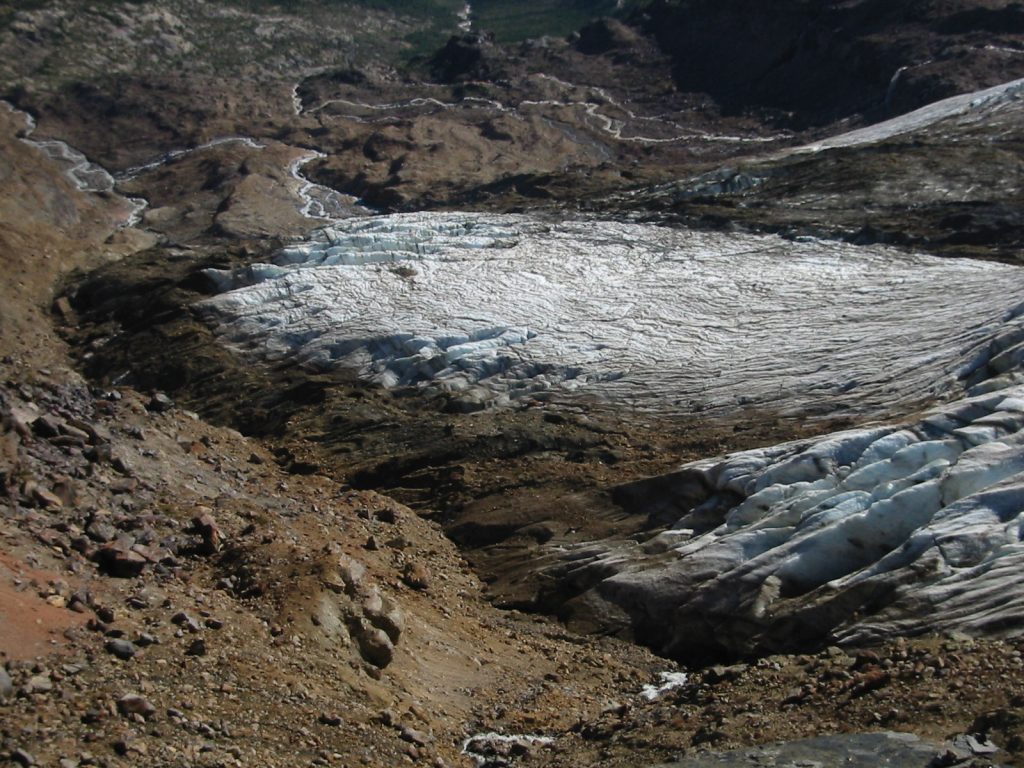
Moraine composed of loose rock and sediment forming at the lateral margin of the Boulder Glacier, Washington, USA. Photo: W. Siegmund.
Moraines are important features for understanding past environments. Terminal moraines, for example, mark the maximum extent of a glacier advance (see diagram below) and are used by glaciologists to reconstruct the former size of glaciers and ice sheets that have now shrunk or disappeared entirely6.

Summary of the main moraine types and their spatial patterns. The top diagram is a cross-section through a cirque glacier. The bottom diagram is drawn in plan view, looking down on the surface of a valley glacier made up of several tributaries. Image created by J. Bendle.
Definitions
The most common moraine types are defined below:
A terminal moraine is a moraine ridge that marks the maximum limit of a glacier advance. They form at the glacier terminus and mirror the shape of the ice margin at the time of deposition. The largest terminal moraines are formed by major continental ice sheets and can be over 100 m in height and 10s of kilometres long7,8.
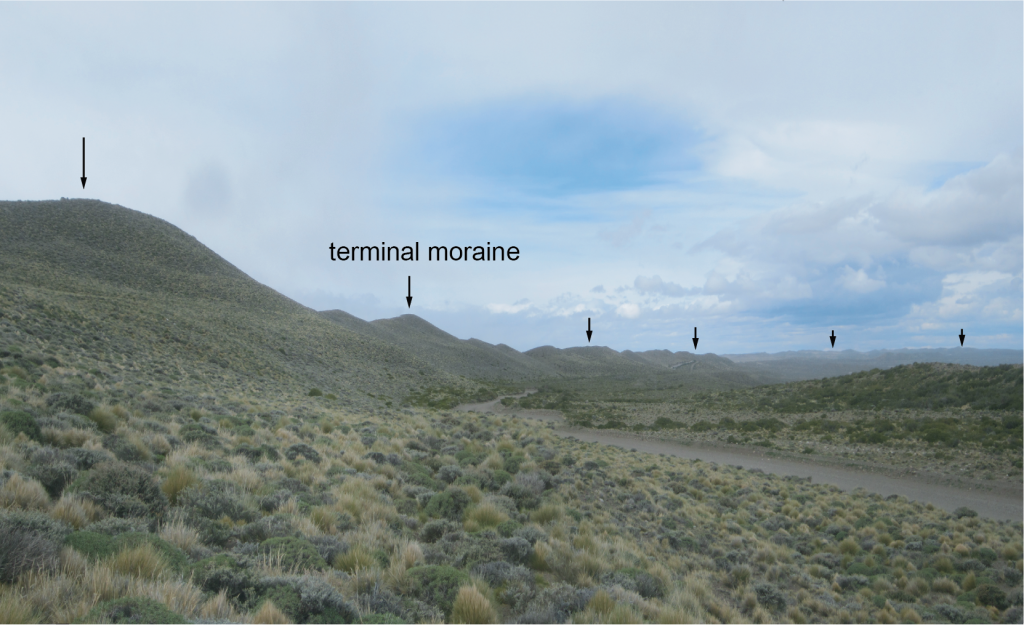
Terminal moraine marking the limit of the former Patagonian Ice Sheet at the Last Glacial Maximum (~25 to 18 thousand years ago). Photo: J. Bendle.
Recessional moraines are found behind a terminal moraine limit and form during short-lived phases of glacier advance or stillstand that interrupt a general pattern of glacier retreat. In some cases, recessional moraines form on a yearly basis (normally as a result of winter glacier advances) and are known as annual moraines9,10,11.
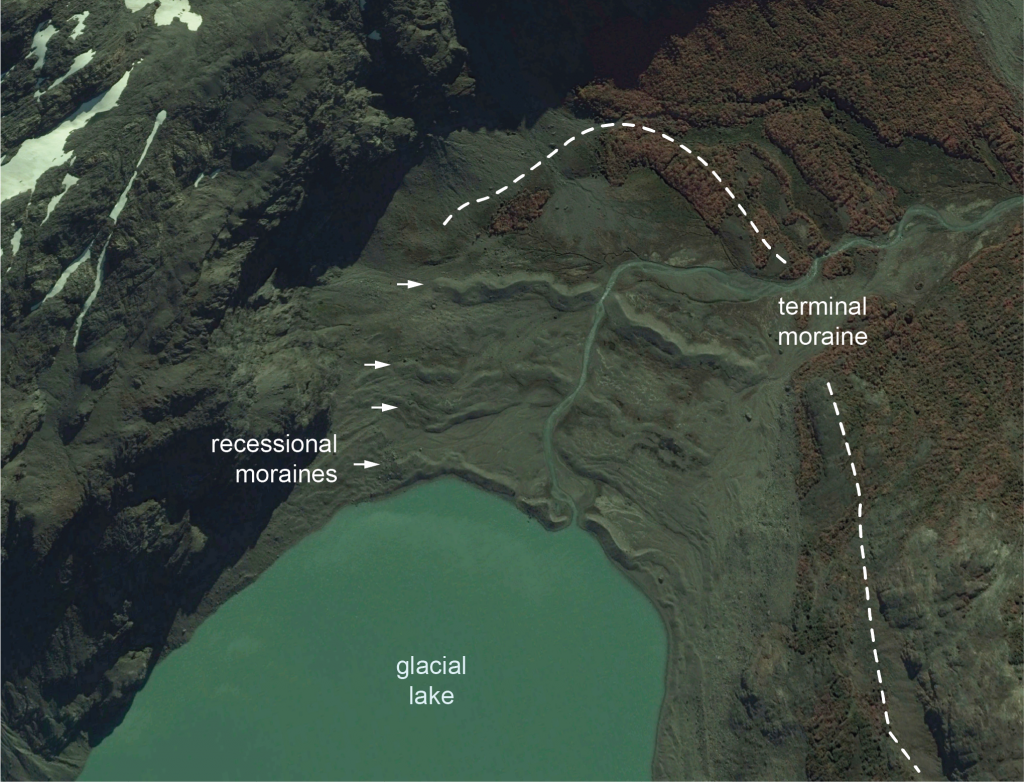
Recessional moraines (arrowed) marking the shrinkage of a South American valley glacier. The glacier (not shown) retreated towards the south-west, leaving behind a moraine-dammed glacial lake. Imagery from GoogleEarth, diagram created by J. Bendle.
Lateral moraines form along the glacier side and consist of debris that falls or slumps from the valley wall or flows directly from the glacier surface12 (see image below). Where the rate of debris supply is high, lateral moraines can reach heights of more than 100 metres12–15.

Lateral moraine of the Callequeo Glacier of the San Lorenzo Icefield in central Patagonia, South America. Photo: J. Martin.
The term latero-frontal moraine is used where debris builds up around the entire glacier tongue14. These moraine types are common in mountain settings such as the European Alps, the Southern Alps of New Zeland (see the Mueller Glacier moraines below) and the Himalayas, where the high supply of rock debris from unstable valley sides, rapidly build up at the glacier margins.
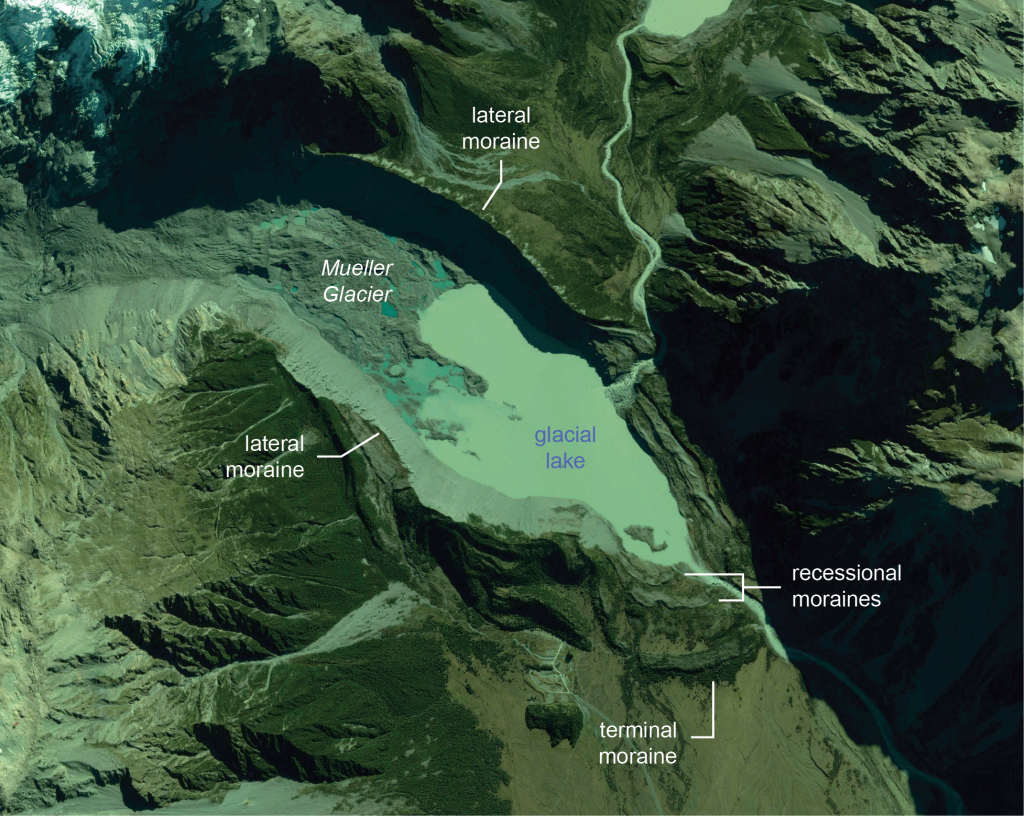
Latero-frontal moraine complex of the Mueller Glacier, South Island, New Zealand. The debris-covered and downwasting Mueller Glacier is flanked by lateral moraines of ~100 m in height, which continue down valley and merge into terminal moraines. Imagery from GoogleEarth, diagram created by J. Bendle.
Medial moraines are debris ridges at the glacier surface running parallel to the direction of ice flow4,5. They are the surface (or supraglacial) expression of debris contained within the ice. Medial moraines form where lateral moraines meet at the confluence of two valley glaciers, or where debris contained in the ice is exposed at the surface due to melting in the ablation zone16.
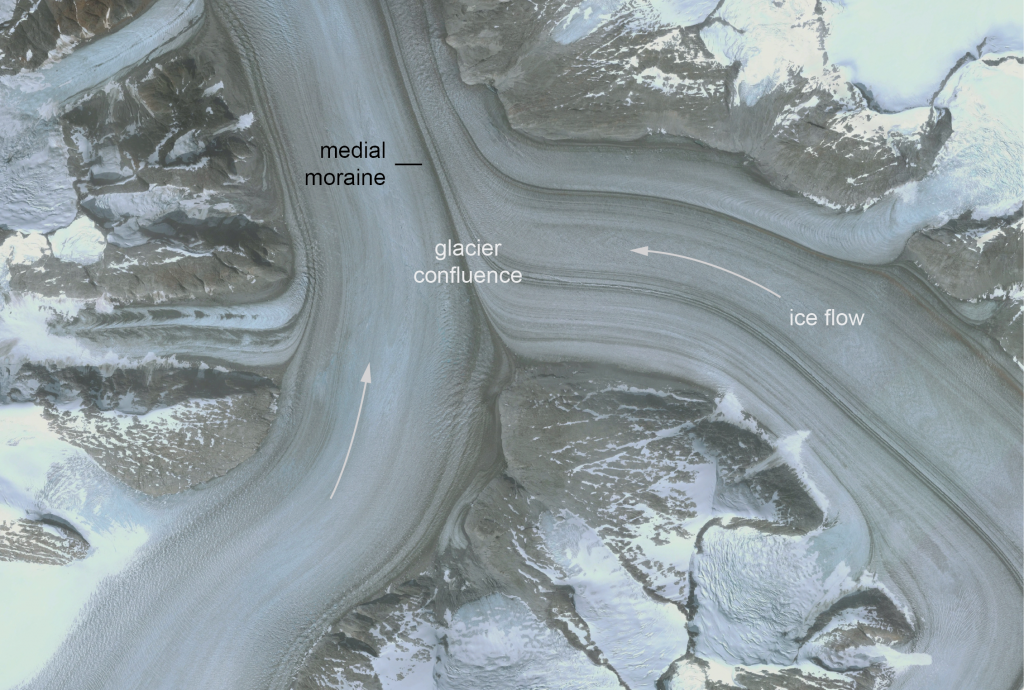
Medial moraines on the surface of an Alaskan valley glacier. In this example, surface debris is concentrated at the point where two glaciers merge. Imagery from GoogleEarth, diagram created by J. Bendle.
Ground moraine is a term used to describe the uneven blanket of till deposited in the low-relief areas between more prominent moraine ridges6. This type of moraine, which is also commonly referred to as a till plain, form at the glacier sole as due to the deformation and eventual deposition of the substratum.
第二章節
冰磧物是指冰川融化以後遺留在地面上的大小石塊或黏土(歐洲)的堆積物,這些堆積物可以造成小山丘或其他地形。有許多不同種類的冰磧,冰川活動切割地景來形成這些冰磧。側磧(lateral moraines)成形於冰川側邊,表磧(supraglacial moraines)成形於冰川上方,中磧(medial moraines)成形於冰川中間,終磧(terminal moraines)則是成形於冰川尾端。
側磧
側磧成形於冰川兩側,隨著冰川刮削,兩側的岩石與泥土剝落,這些物質隨著側磧沉積於冰川邊緣,側磧通常可在冰川兩側發現,冰川擠壓這些物質同時到峽谷兩側,所以側磧通長會在相近的高度。若冰川融化,側磧還會維持在峽谷的高處邊緣。
中磧
中磧可在冰川中間上方發現,中磧是兩個冰川相遇的時候形成,兩個側磧被不同冰川推擠在一起,這些物質形成新的、更大的冰川中一道岩石與髒汙線。若冰川融化,中磧會留在後方形成峽谷中一道山脊長線。
表磧
表磧是冰川表層的物質,側磧和中磧都可以是表磧,表磧由岩石和周遭地形的物質掉落到冰川上才形成,風和雨水帶來的灰塵與髒污也會成為一部分的表磧,有時候表磧非常厚重,也會遮住看不到下方的冰河。若是冰川融化,表磧會平均地分布在峽谷中。
底磧
底磧是冰川移動時捲起地表植被或其他植物而形成,他們通常不向其他冰磧有銳利的脊線,底磧由冰川底下細流逐漸累積的沉積物構成,或是冰川碰觸到山丘或是峽谷擠壓而成,當冰川融化時,底磧會暴露出來。
終磧(或尾磧)
終磧有時又被稱為尾磧,即是在冰川的尾端形成,可以讓科學家發現到冰川的重要訊息、也可知道冰川如何移動。在終磧的位置,所有被冰川挖出的碎屑都被擠壓到冰川最前端,沉積在此處成為大叢的岩石、泥土、和沉積物。
科學家研究終磧來知道冰川在哪裡移動、和移動的速率。不同的岩石與礦物分布在冰川路徑的特定位置,若是某種礦物專屬於某個地點卻出現在終磧的位置,這樣地質學家就可以知道冰川有流過那個區域。
Logging Requirements
In order to log a Found It! on this Earth Cache, please send me the answers to the following Task Questions:
Task 1:
Based on what you have learned from above about characteristics of Meteorites, take a walk around Jiaming Lake and observe the rocks. Describe their appearance. Also, pick up some of the rocks and compare their weight. Are rocks of similar size and shape the same weight or are some heavier than others? Lastly, use a strong magnet to test if these rocks have any magnetic charge to them.
Task 2
Based on what you have learned from above about Glacial Moraines, take a walk around Jiaming Lake and observe any characteristics present that would indicate the former presence of a glacier here. Based on what you observe, what defining characteristics, if any, can you see of Glacial Moraines?
Task 3
Based on your observations on the on-site tasks you completed, which theory is more likely to prove how Jiaming Lake formed? What factors do you think cause the debate over how this lake was formed?
Task 4
Optional — Post of picture of you with your GPS at Jiaming Lake
登錄任務
線上登錄這個地質寶,請將下列任務的答案寄給我。
任務一:
根據上方頁面隕石相關知識,沿著嘉明湖走一下與觀察岩石,描述它們的外貌。此外,請撿起一些石頭,比較它們的重量,相似大小與形狀的石頭重量是否一樣?最後,使用強力磁鐵做個檢測,看看這些石頭是否有任何磁性。
任務二
根據上方頁面冰磧知識,沿著嘉明湖走一下與觀察是否有冰川存在的證據。根據你的觀察,有沒有任何冰川冰磧的特徵?
任務三
根據你在現場的觀察與實際檢驗,嘉明湖比較可能是哪個形成理論?你覺得哪些因素造成嘉明湖成因的爭議?
任務四
選擇性-上傳你與你的GPS裝置在嘉明湖的照片
You may log your find as soon as you send me your answers, but you must visit the site and complete the tasks. Please uphold the integrity of this game and do not log this cache unless you actually visit this Earth Cache. I hope you enjoy your visit to Jiaming Lake!
寄送答案後就可以線上登錄,不過你必須實際拜訪這個地點與完成這些任務。為了維持遊戲的完整性,請不要線上登錄,除非你有實際拜訪這個地質寶。希望你喜歡造訪嘉明湖。